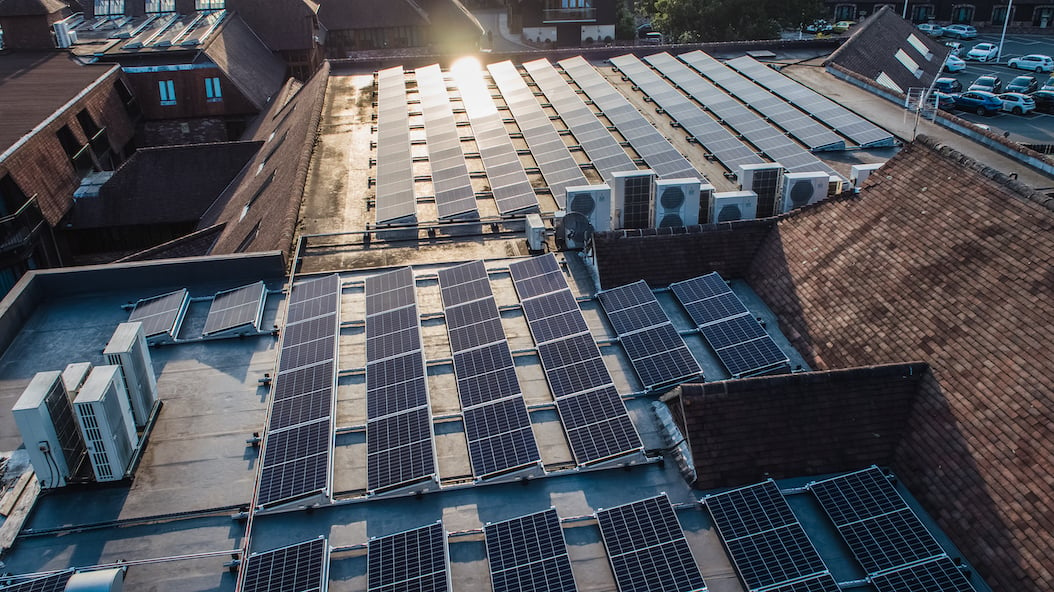
While the methods are different to sloping roofs, yes, you can install solar panels on flat roofs. In fact, there are potential advantages, such as:
But there are also considerations particular to flat roof solar, such as mounting, roof structure, warranties and ballasting - all of which are covered in detail below.
Solar panel installations often fall under permitted development and normally will now planning permission rules have been eased for domestic installs. However there are a few conditions exclusive to commercial flat rooftops:
See our page on planning for more details.
A flat roof solar system usually costs around £750 - £900 per kWp to install at a commercial premises. The yearly savings and income will depend primarily on the cost of electricity displaced and the percent of electricity used on site. As an average, each kWh will be worth around 27p per kWh for commercial sites, and each kWp installed will yield 890 kWh every year. So each kWp installed will generate savings / income of ~ £240 per year.
The simple payback time will be between 7 and 9 years, compared to a system life of 25+ years.
For a quick quote, try our solar calculator:
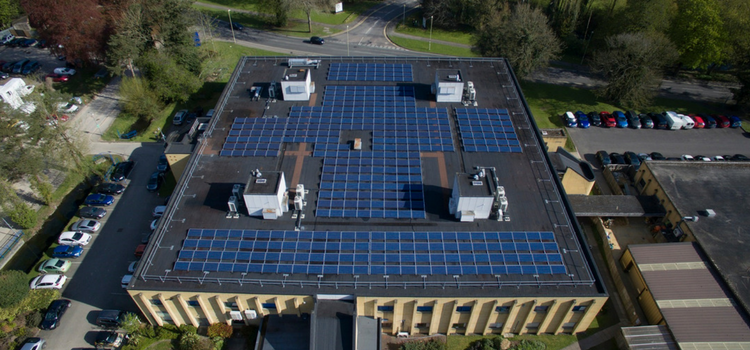
One of the most common areas of misunderstanding surrounding flat roof solar installations is the panel mounting angle.
Solar panels (in the UK) produce most power when mounted at between 30 and 40 degrees to the horizontal, facing due south. It is therefore natural to assume that this is the best angle to tilt them at for flat roof installations. But this is not usually the case, as there are other factors that come into play with flat roof mounting:

Mounting the panels below 30 degrees helps to minimise wind uplift and roof loading, and maximise the number of panels for a given roof space. A mounting angle of 10 degrees generally offers the optimum compromise between performance, ballast requirement, area required and installation cost.
| Degrees from south | 10° output/m2 (kWh/yr) | 30° output/m2 (kWh/yr) | Increased output at 10° |
| 0 | 84.3 | 55.3 | 52% |
| 10 | 84.2 | 55.1 | 53% |
| 20 | 83.9 | 54.7 | 54% |
| 30 | 83.5 | 53.9 | 55% |
| 40 | 82.8 | 53.0 | 56% |
| 50 | 82.0 | 51.7 | 58% |
| 60 | 80.9 | 50.3 | 61% |
| 70 | 79.9 | 48.6 | 64% |
| 80 | 78.7 | 46.9 | 68% |
| 90 | 77.4 | 45.0 | 72% |
As the table shows, panels mounted at 10 degrees will yield between 52% and 72% more power per unit area of roof space (once the spacing required between rows is taken into account).
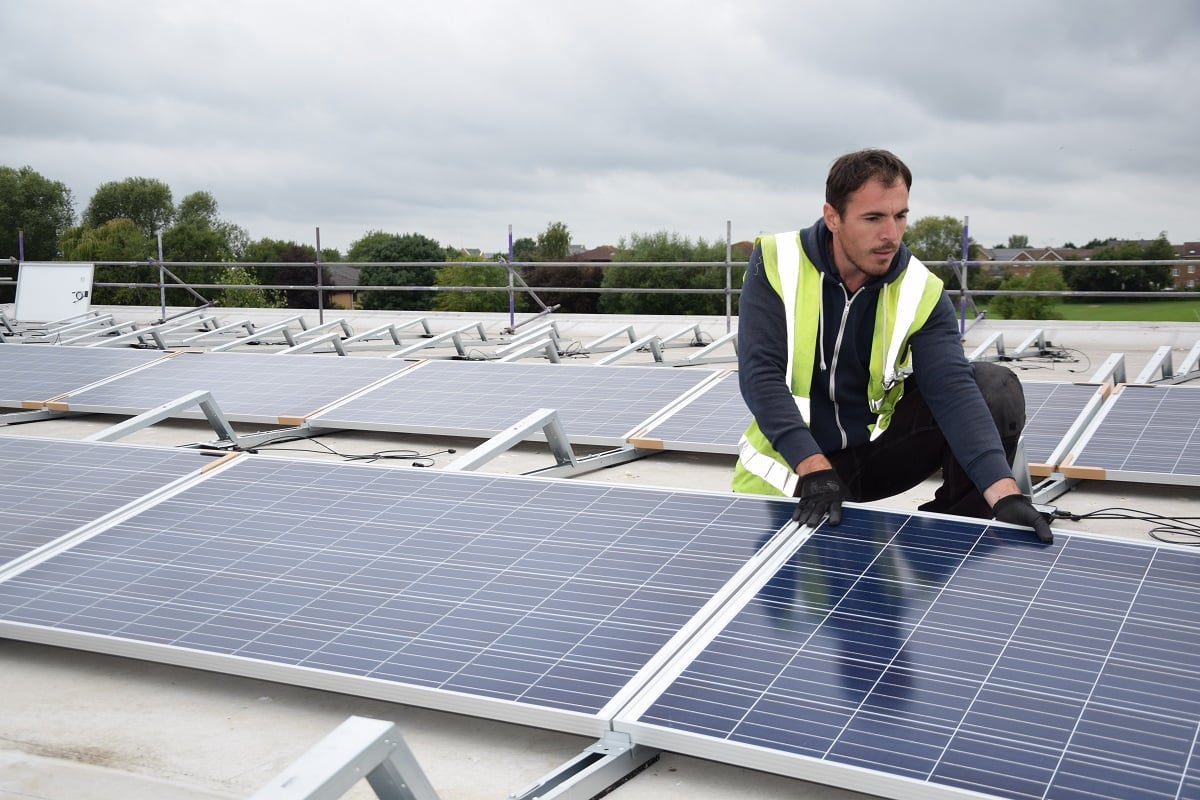
As mentioned above, solar panels installed in the UK will produce most power when angled between 30 and 40 degrees and facing due south. But what if your roof doesn't face due south? Should the panels be rotated to face south anyway? Or what about an east/west configuration?
As with a pitched roof installation, solar panels on a flat roof can be orientated as much as 90 degrees off south, to face directly east or west, and still be worthwhile considering in terms of output performance.
It is usually best to orientate the panels in line with the footprint of the building in order to achieve the optimum number of panels within the roof area. There is little benefit in rotating the array to face due south as this leaves dead space that could otherwise be used to fit more panels. See pictures below.
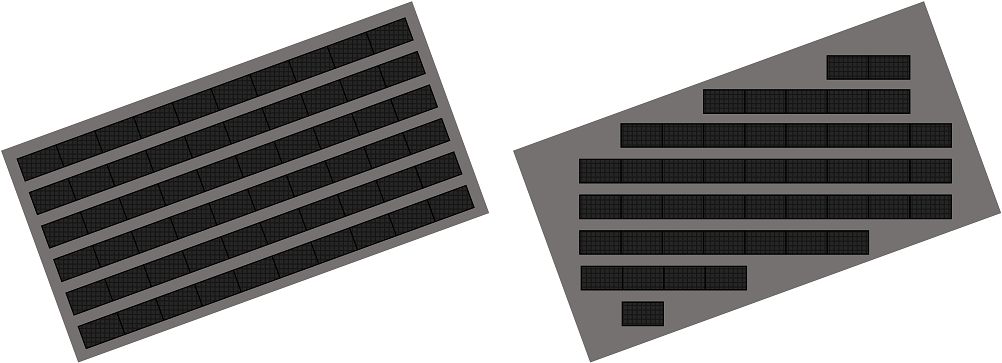
In line with roof vs due south panel layouts for flat roof.
In the above example we can get 30% more panels by installing in line with the roof footprint (allowing for suitable edge distances). This contrasts with just a 0.5% drop in output due to the less favourable orientation (20 degrees off south).
It is worth highlighting that at a 10 degree pitch, the difference in output between panels mounted due south and panels mounted east or west is much lower than it is for a system pitched at 30 degrees - see table above.
For buildings with footprints aligned roughly south, another mounting option to consider is an east/west configured system. These use the same A-frames, tilted at 10 degrees, as with the south-facing systems, but set back to back so that the panels are orientated at 180 degrees from each other (due east and west ideally).
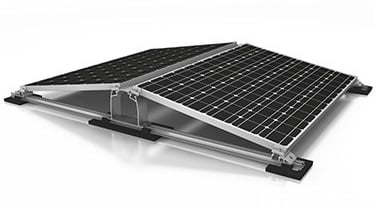 East/west systems maximise the power output (number of panels) per square metre of roof, since no spaces are required between rows. The lower performance of the individual panels due to the less favourable orientation is therefore offset by the extra capacity. On a per unit area basis, a 10 degree east/west system outperforms a 10 degree south-facing system by up to ~25%.
East/west systems maximise the power output (number of panels) per square metre of roof, since no spaces are required between rows. The lower performance of the individual panels due to the less favourable orientation is therefore offset by the extra capacity. On a per unit area basis, a 10 degree east/west system outperforms a 10 degree south-facing system by up to ~25%.
On top of the performance benefits, east/west systems also require lower ballast. However, because of the reduced performance on the individual panel level, east/west systems are more expensive per kWh than south-facing systems. Despite this, providing the building footprint can accommodate an orientation as close to east-west as possible, an east/west mounting system is usually preferable for the other reasons outlined above.
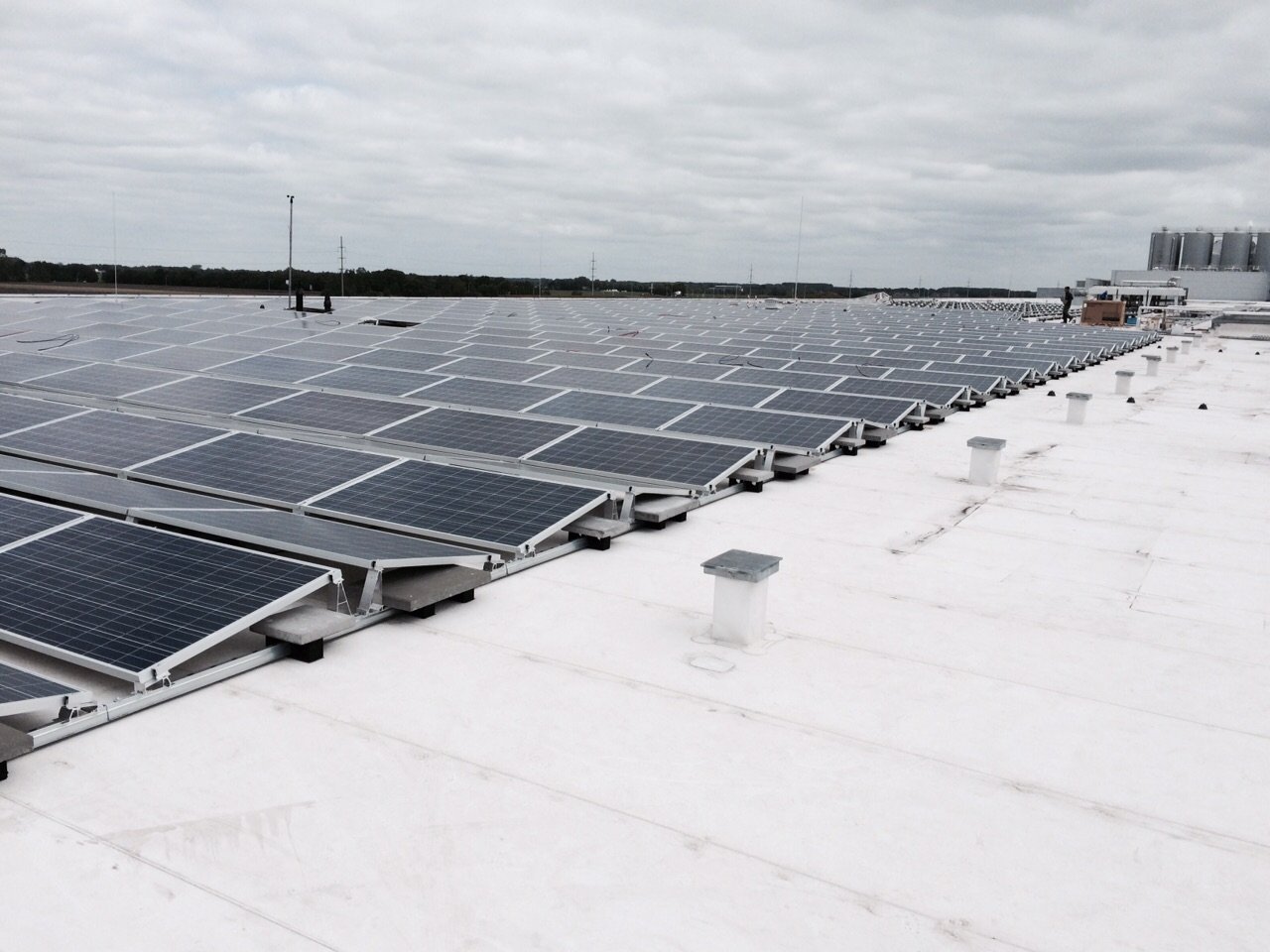
In most situations, a free-standing ballasted flat roof solar mounting frame is preferable. Using a free-standing mounting system weighed down with ballast, avoids the need to penetrate the roof surface. This helps to minimise the risk of roof leakage, and ensures that any warranties on the watertightness of the roof aren’t compromised – particularly important if your roof is brand new.
With ballasted systems, the solar mounting frames rest on special rubber footings to help spread the load. The ballast itself comes in many forms, and preference may vary from installer to installer. At Spirit we use preformed concrete ballast as it looks neat and tidy and will stand the test of time.
In some cases, however, ballasting isn’t a viable option; for example, if the roof cannot take the weight of the ballast, or where the ballast requirement is so high (e.g. tall buildings) that there is not enough space under the panels to fit it all! There may be no choice but to fix directly to the structure of the roof. This is more complicated than using ballast, as input from the roofing manufacturer is usually required to ensure that the fixings are adequately sealed against water ingress. There are systems available but they usually require a new roof covering and they can be quite expensive.
The choice of fixing will depend on the roof system manufacturer - they often have their own specialist fixing. Other universal fixings exist; please get in touch for more information.
None of these factors mean that it isn’t worth looking at a flat roof system: they simply mean that the process is more involved and it is more important than ever that the system is designed and installed by knowledgeable experts.
At Spirit we have undertaken planning applications for, and installed, a large number of flat roof systems on a variety of properties using different mounting systems and as such are able to advise on the best solution for any given property.
Copyright © Spirit Energy 2025 · info@spiritenergy.co.uk · 0118 951 4490
Jobs and Careers
Interested in joining the Spirit team? Email jobs@spiritenergy.co.uk
Spirit House, 25 Albury Close, Reading, RG30 1BD
(Location formerly known as 44 Portman Road, Reading, RG30 1EA)
Spirit Energy is the trading name of Spirit Solar Ltd · UK Company Number 07138647
Although care is taken to ensure that the information on our website (www.spiritenergy.co.uk) and any guides, calculators or checklists provided by us, electronically or otherwise, are accurate and up-to-date, we cannot accept any responsibility for mistakes or omissions. We enter into no express or implied conditions, warranties, terms or representations regarding the quality, accuracy or completeness of the information. We exclude to the extent lawfully permitted all liability for loss or damage, whether direct, indirect or consequential arising out of your use of our website or any guides, calculators or checklists provided by us, or from any information or omission contained in our website or any guides, calculators or checklists provided by us.